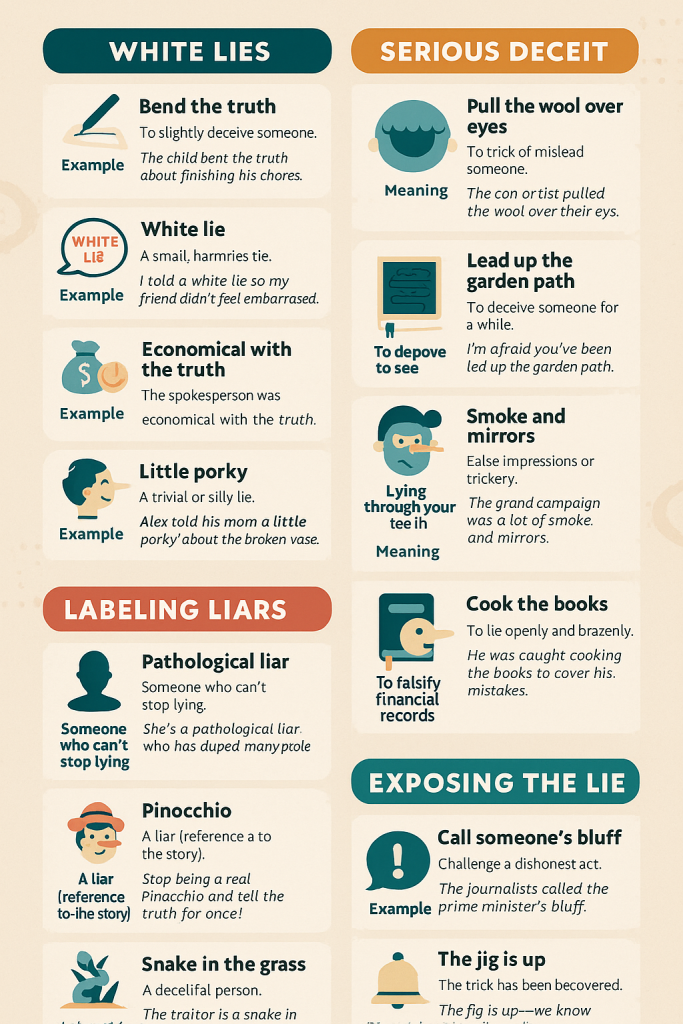Honesty is an integral part of any relationship. People need to know they can trust the person they are dealing with, whether it is a family member, teacher, coworker, boss, or a salesperson at a store. Unfortunately, there are many dishonest people in the world and even those who are usually honest may not always tell the full truth all the time. Idioms, which are a combination of words with a figurative rather than literal meaning, can help us describe someone’s perceived ability (or lack thereof) to tell the truth. They can also help us explain how and why the person was dishonest.
What Counts as a Lying Idiom?
There are many synonyms for lying. Words such as “dishonest”, “fabricate”, “untruthful”, “mendacious”, and “misleading” show that someone isn’t telling the truth. However, idioms are different from synonyms because idioms are phrases rather than single words. Idioms also employ figurative language rather than literal expressions. This can make idioms difficult to understand if you’re learning English as a second language, but it’s also part of what makes English as rich and colorful as it is today.
Additionally, idioms distinguish between various levels of dishonesty. They can help us understand the difference between a person who tells a small lie to protect a friend from an embarrassing situation and a person who always tells lies for personal gain. They can also help us tell the difference between lies and criminal activity.

Idioms for Minor Lies
1. Bend the truth
Meaning: To change or omit certain parts of a story or event
“She bent the truth, so her mom wouldn’t know she flunked the test.”
2. White lie
Meaning: A small, harmless lie told to avoid hurting someone’s feelings.
“He didn’t like the cake, so he told a white lie to avoid eating it.”
3. Economical with the truth
Meaning: To withhold information, often by being vague.
“The business owner was economical with the truth when applying for a loan from the bank.”
4. Fudge the facts
Meaning: To exaggerate or downplay some information in order to give a false impression
“Don’t fudge the facts; tell me exactly why you picked a fight with Kenny.”
5. Massage the numbers
Meaning: Adjust figures or stats to give a false impression
“The teacher won’t massage the numbers to make her students look better.”
6. Little porky
Meaning: British English expression for a small lie or a lie about something that isn’t too important.
“She told a little porky to get out of doing extra chores.”
7. Stretch the truth
Meaning: To exaggerate or distort facts, usually to make something or someone look better.
“She said her dress was the most expensive one at the party, but she’s stretching the truth.“
Idioms for Serious Deceit
1. Pull the wool over someone’s eyes
Meaning: To trick or take advantage of someone
“He pulled the wool over his brother’s eyes to trick him into giving up his toy.”
2. Lead someone up the garden path
Meaning: To mislead someone and deliberately give them the wrong impression about something
“Her boss promised to promote her, but he was really leading her up the garden path.“
3. Cook the books
Meaning: Falsify financial records
“He stole money from the company and cooked the books to hide the theft.”
4. Sell someone a bill of goods
Meaning: Trick someone into believing something that’s not true.
“She thought she was buying the best shoes on the market, but she was sold a bill of goods.“
5. Snow job
Meaning: to trick or deceive, often through flattery
“He gave me a snow job, hoping to convince me to lend him money”
6. Smoke and mirrors
Meaning: illusion, not real
“The company looked like it was doing well financially, but it was all smoke and mirrors.“
7. Lying through your teeth
Meaning: Tell someone something that is completely false
“The student lied through his teeth when he said he passed the test.”
8. Con job
Meaning: Tricking someone into giving up money
“The offer wasn’t legitimate; it was a con job that tricked her into giving up her personal information.”
Idioms that Label a Liar
1. Pathological liar
Meaning: Someone who lies all the time, almost as if he or she can’t help it
“Tony is a pathological liar; he even lied about what he ate for breakfast.”
2. Pinocchio
Meaning: Someone who lies frequently.
“She is such a Pinocchio; I don’t believe anything she says.”
3. Two-faced
Meaning: Insincere, double-dealing
“The two-faced worker only did a good job when the boss was around but then stole money when the boss wasn’t looking.”
4. Wolf in sheep’s clothing
Meaning: Someone who appears good but is actually dangerous.
“The criminal looked like a nice person, but she was a wolf in sheep’s clothing who even stole from senior citizens.”
5. Snake in the grass
Meaning: Someone who tricks or deceives others to reach his or her own goals.
“My co-worker seems nice, but she’s really a snake in the grass who tells lies about other people in the office.”
6. Tall-tale teller
Meaning: Someone who tells obvious lies
“My brother’s a tall-tale teller; he says he caught ten fish, but he really caught one.”
Idioms for Exposing a Lie
1. Call someone’s bluff
Meaning: to expose someone being untruthful.
“She said she didn’t steal the bag, but her store called her bluff by asking for the receipt.”
2. The jig is up
Meaning: People know that someone is lying
“The jig is up; your teacher told us that you failed the test.”
3. Let the cat out of the bag
Meaning: To expose that someone isn’t telling the truth or is covering up something
“No-one was supposed to know Andy was being fired, but the boss’s secretary let the cat out of the bag.“
4. Caught red-handed
Meaning: caught in the act of being dishonest
“The students tried to cheat on their tests but were caught red-handed.“
Classroom and Writing Tips
- Some idioms are slang while others are formal. If you’re completing a writing assignment, check how and when the idiom should be used before including it in your content. If you’re writing a paper, you cannot use idioms about liars to describe someone unless you have proof that the person is lying or has lied in the way that you’re describing.
- Accusing someone of dishonesty is almost always offensive, but some idioms for lying and dishonesty are more offensive than others. Use these with care, especially if you aren’t 100% certain someone is lying to you, or lying with malicious motives. For example, someone who “lets the cat out of the bag” may have accidentally spilled a secret. On the other hand, a person who is a “snake in the grass” has a sneaky, dishonest character and cannot be trusted under any circumstances.
- Role-play is an ideal activity for learning how to use idioms for dishonesty. Use various scenarios to understand which idioms are best for specific situations, as some figurative language for liars can only be used in specific settings. “Cooked the books,” for example, is only used in the business world, while “leading up the garden path” can be used to describe a situation at work, home, or school.
🧠 Quiz: Idioms for Lying and Dishonesty
Test your knowledge of the idioms you just learned! Each question has one correct answer. Choose wisely and see how well you understand common phrases used to describe dishonesty and deception.
1. What does “white lie” mean?
2. “Pull the wool over someone’s eyes” means:
3. Which idiom means “to be caught in the act of doing something wrong”?
4. “Cook the books” refers to:
5. What kind of person is a “snake in the grass”?
6. What does “stretch the truth” mean?
7. “Two-faced” describes someone who:
8. Which idiom means “to make something sound better than it is”?
9. If someone is “caught in a lie,” what likely happened?
10. “Call someone’s bluff” means:
FAQs
“Pathological liar” and “Pinocchio” are good idioms for someone who lies a lot. If the person continually lies for personal gain or to cheat someone, you can also describe them as a “snake in the grass” or “wolf in sheep’s clothing.”
“White lie” is an idiom as it uses a figure of speech. White is commonly viewed as the color of purity; thus, a “white lie” is a lie that is told to protect someone from embarrassment.
It’s a good idea to explain to students that most idioms involving lying are inherently impolite and should be used with caution. Make sure your class knows that example sentences that they give at your request cannot degrade or insult anyone in the class
“Pull the wool over someone’s eyes” means deceiving or tricking someone once, while “lead up the garden path” implies that someone is regularly lying to a person about a particular situation. For instance, a co-worker can “pull the wool over your eyes” by telling you that you need to complete one of her assignments, but she’s “leading you up the garden path” if she tells you that you have to do that same job every single day for the next six months.
Conclusion
Learning how to use deceit idioms and figurative language for lying isn’t easy, nor is it as pleasant as working with idioms for honesty. Reading books and watching videos with these idioms being used in various settings can help you understand the cultural nuances behind using certain idioms and figurative phrases for dishonesty. What’s more, if you’re not 100% sure that a phrase or expression is appropriate for a certain situation, don’t use it. It’s far better to avoid saying anything than it is to insult or accuse someone of dishonesty.
✏️ Worksheet: Idioms for Lying and Dishonesty (With Answer Key)
Reinforce what you’ve learned with this printable worksheet that explores 25 idioms related to lying, trickery, and deceit. Designed for classroom or independent practice, it includes matching activities, fill-in-the-blank sentences, a creative writing section, and a reflection question—plus a full answer key to guide discussion or grading. Perfect for ESL learners and figurative language lessons.
🎓 PowerPoint Lesson Plan: Idioms for Lying and Dishonesty
Teach students in Grades 7–12 or intermediate to advanced ESL learners how to recognize and use idioms related to lying, deceit, and dishonesty. This ready-to-use PowerPoint lesson includes simple definitions, real-life examples, cultural notes, and interactive classroom activities. The structured format introduces 25 common idioms in grouped categories—perfect for building figurative language skills in English, ELA, or writing classrooms. A printable worksheet and optional quiz are included for review and reinforcement

